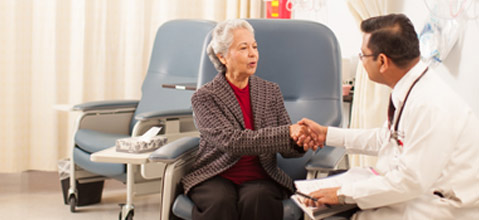Oncologists divide lung cancers into two main types of lung cancer, based on how the cells look under a microscope: non-small cell cancer and small cell cancer. About 230,000 new cases of lung cancer (both types combined) are diagnosed each year in the United States. Approximately 90% of lung cancer cases are caused by smoking.
Non-Small Cell Lung Cancer
About 85% of lung cancers are non-small cell lung cancers. Subtypes of non-small cell lung cancer: adenocarcinoma, squamous cell carcinoma and large cell.
Small Cell Lung Cancer
About 10%-15% of lung cancers are small cell lung cancers, which are aggressive forms of the disease and tend to spread quickly.
Lung Carcinoid Tumor
This is a relatively rare form of lung cancer — fewer than 5% of lung cancers are lung carcinoid tumors. These slow-growing tumors are sometimes called lung neuroendocrine tumors.
Lung cancer is stealthy, often symptomless until the later stages of the disease. Once lung cancer has advanced, these symptoms may occur:
- Shortness of breath
- Chest pain
- Wheezing
- Hoarseness
- A persistent new cough
- Changes in a chronic cough or “smoker’s cough”
- Coughing up blood, even a small amount
- Losing weight unintentionally
- Bone pain
- Headache
The symptoms listed above can be caused by conditions other than lung cancer. Only a doctor can make a diagnosis of cancer.
Surgery
Surgical removal of the tumor and some surrounding tissue may be the first step in treatment. Your surgeon may also remove nearby lymph nodes to see if the cancer has spread. Surgical procedures to remove lung cancer can include:
- Wedge resection: removal of the lung tissue where the tumor is growing, plus a margin of surrounding tissue
- Segmental resection: removal of a larger section of lung, but not an entire lobe
- Lobectomy: removal of the entire lobe of one lung
- Pneumonectomy: removal of an entire lung
Chemotherapy
One or more cancer-killing drugs (chemotherapy) may be given intravenously or taken orally. Chemotherapy usually takes place over a period of weeks or months, with breaks in between for recovery. Chemotherapy is often given after surgery to kill any remaining cancer cells. Sometimes it’s used before surgery to shrink tumors for easier removal. Chemotherapy is also useful for relieving pain and other symptoms of advanced cancer.
Targeted drug therapy
These newer cancer treatments target specific abnormalities in cancer cells and work by disrupting growth of new blood vessels that feed the tumor or blocking the chemical signals that make the tumor grow.
Radiation therapy
- Stereotactic body radiotherapy: small lung tumors may be treated with stereotactic body radiotherapy, which aims many beams of radiation from different angles at the lung cancer.
- External beam radiation: radiation therapy directed at the lung cancer from outside the body
- Brachytherapy: radiation in needles, seeds or catheters and placed inside the body in or near the tumor
Advances in research, clinical trials and state-of-the-art treatment modalities are improving lung cancer prognoses. These are some of the recent research developments:
Personalized therapy: studies of specific features of lung tumors that can determine whether a certain type of chemotherapy or targeted therapy may be effective.
Immunotherapy: also called biologic therapy, this innovative treatment aims to boost the body’s natural defenses to fight the cancer.
Video-assisted thoracoscopic surgery (VATS): allows lung surgery to be done through very small openings in the chest, which reduces stress on the body and may speed recovery.

Multidisciplinary Cancer Treatment
